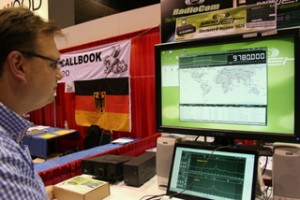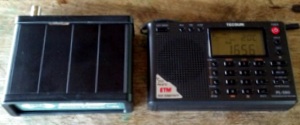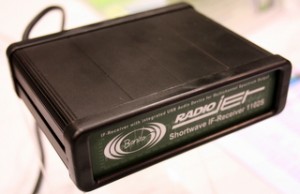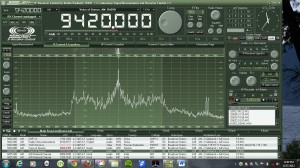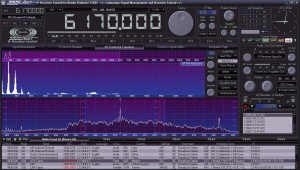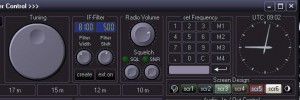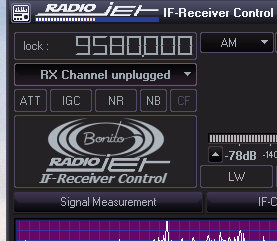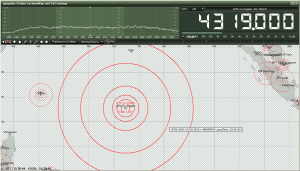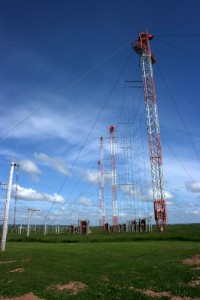I recently discovered that Bob Padula, long-time shortwave radio enthusiast and publisher of The Australian DX Report, has an online project entitled The History of Shortwave Radio In Australia. It’s a thorough and informative read and is available free of charge.
Monthly Archives: July 2012
Updates to the WRTH Summer A12 schedules are now available for download
 The World Radio TV Handbook (WRTH) has updates their A12 International Radio Supplement as of July 13. The file is now available to download, free of charge, from the WRTH website. This is a comprehensive update and supplement to the printed 2012 WRTH.
The World Radio TV Handbook (WRTH) has updates their A12 International Radio Supplement as of July 13. The file is now available to download, free of charge, from the WRTH website. This is a comprehensive update and supplement to the printed 2012 WRTH.
A Review of the Bonito 1102S RadioJet 24 bit IF Receiver
At the Dayton Hamvention this year, I met Dennis Walter, who is with Bonito, German manufacturer of the 1102S RadioJet. Dennis was kind enough to loan us a radio for review on SWLing.com. I have been evaluating the Bonito 1102S RadioJet over the course of eight weeks and have formed some impressions about its performance. And while I haven’t made any A/B comparisons yet with either the Microtelecom Perseus or the WinRadio Excalibur–both on my review table at the moment–I have taken the time to get to know this lean, high-performance IF receiver.
First impressions
When I first held the RadioJet, I was amazed at how small and sturdy the unit is. It’s built quite well; I expect you would have difficulty putting a dent in its aluminium body. It has a very small footprint on the desktop and fits very easily in my suitcase. Specifically, the RadioJet box is about the size of the highly portable Tecsun PL-380—in fact, the PL-380 is slightly wider than the RadioJet.
And though I knew about this feature in advance, what really stands out is its lack of dependence upon a power cable or a DC-in jack on the back of the unit. Indeed, the only two connections are a USB port and a female BNC connector for the antenna. The RadioJet derives its power directly from the USB cable. This is a major plus, providing additional freedom, as there’s no need for an external power supply or “wall-wart” type DC adapter. With the radio and USB cord, you’re ready for radio on-the-go—as I was on my recent DXpedition family vacation, when I reviewed the RadioJet.
Plug and play
Installing the RadioJet is very simple. You simply plug the receiver into your computer via the supplied USB cable, then install the RadioJet software via the supplied installation disc. As far as I know, the RadioJet software only works with Windows PCs. I tested the RadioJet with my Toshiba Satellite 64 bit Intel core i3 laptop computer.
I had no difficulty getting the RadioJet running. Indeed, it worked after the first software install. In my experience, it was true plug-and-play.
To be clear, the RadioJet is technically not an SDR, it is an IF receiver, more like the Ten-Tec RX-320D. I’ve certainly been guilty of calling it an SDR in the past as it’s easily to lump it in the same category. Within this review, I do compare RadioJet features with SDRs currently on the market since it is software (PC) controlled, has many of the same features as an SDR and directly competes with them.
Software and Usability
Unquestionably, the Bonito 1102S RadioJet’s software offers the most flexibility of any Software Defined Radio (SDR) or IF receiver I’ve ever reviewed.
Having used several SDRs and IF receivers–including the Microtelecom Perseus, Ten-Tec RX-320D, RFspace IQ and WinRadio Excalibur—I can state that the basic functions of the RadioJet are comparatively easy to locate. The graphic user interface (GUI), however, could appear somewhat complicated, particularly if you are new to software based receivers. While I like options and the ability to customize a user interface to best match my preferences, having a GUI that is both highly-adaptive and full-featured can be a double-edged sword until you become accustomed to it.
On one hand, you can customize the RadioJet GUI more completely than any other SDR I’ve ever used: you can change the window size, layout, spectrum display, and color palette; you can also load pre-designed screens to help with signal measurement, IF control, and AF control. Indeed, the RadioJet’s designers have also included a unique “Scanner and Signal Utilities” screen for working with utility reception.
On the other hand, there is a learning curve in both customizing the GUI and familiarizing yourself with the radio’s controls. This is why I wish the RadioJet had a proper owner’s manual. Early in my experience with the unit, while making setting modifications during a broadcast, I found I could lose my place within the control settings or accidently alter a setting that would result in degraded reception (such as the WAV volume, AGC, DSP or attenuator). I thought that the RadioJet was malfunctioning, only to discover that I had a setting adjusted incorrectly. Note that Bonito’s online support, however, has been very responsive in helping me when this happens.
Fortunately, Bonito is fully aware that many listeners could be overwhelmed by the various options the RadioJet offers, and have designed the GUI so that if you minimize the window (as you would any Microsoft Windows “window”), only the basic receiver options will display.
The only major drawback I’ve observed with the RadioJet, as fellow reviewer Fenu mentions in his comprehensive review, is that its software still has a few trouble spots to be ironed out. This is not surprising, considering that is very new to the market. To be clear, software is a very important part of an SDR or IF receiver’s usability: after all, its interface is software defined. An SDR or IF receiver without the software is merely a small paperweight–but with it, becomes highly functional radio with a performance that can be enhanced with upgrades over time.
The success of the RadioJet over time will be directly tied to the responsiveness of Bonito to customer feedback. Like Fenu, my experience with Bonito is quite encouraging in this regard—Bonito has even provided remote desktop help sessions for individuals, and I can personally vouch that I’ve benefitted from this support. Bonito also closely attends to discussions on the RadioJet Yahoo Group, indicating that the company is listening to their customers. Bonito has been updating the software regularly—in fact, they’ve just added a noise blanker to the software which, I hear, effectively deals with electrical pulse noises like those produced by electric fences.
Though not required, if you don’t already have a mouse with a scrolling wheel, you will want one to tune and adjust the RadioJet. Band-scanning is pretty straightforward and there are a variety of methods to adjust the frequency:
- Hover your mouse over the tuning knob and click to rotate clockwise or counter-clockwise
- Hover over the digital frequency display and use the mouse scroll wheel to adjust each digit of the frequency up or down
- If the display is expanded, there is also a number pad where you can click on each number to adjust
- In the current revision of the software–much like with the Perseus–you cannot directly key in the frequency with the number pad of your computer
With the scroll wheel of the mouse, you can easily adjust most settings and filter controls of the RadioJet. It acts, in a sense and in most cases, as a proxy for a tangible knob you would have on a traditional radio. I imagine there are other (perhaps even better) peripherals that would work, too.
I do find the controls a bit frustrating to manipulate if you do not have at least a mouse with a scrolling wheel. I did not bring a mouse on my recent DXpedition and later regretted the decision. The track pad on my Toshiba laptop does not offer the accuracy and scrolling features needed to fluidly operate the RadioJet GUI.
Recording
Unlike a lot of SDRs on the market, the RadioJet does not have the ability to record large chunks of HF spectrum. For example, the WinRadio Excalibur and Microtelecom Perseus can record 2,000 kHz of spectrum; the RadioJet, however, is limited to 24 kHz. I asked Dennis at Bonito about this and he said that when designing the RadioJet the designers focused on the performance of the received signal and the radio’s overall efficiency rather than upon having a wide IQ output.
Bonito is catering to the discriminating DXer who is seeking the highest quality signal upon receiving, even among weak signals, but who is less interested in spectrum recording. Personally, I like to record and archive spectrum, but I do appreciate this focus upon delivering the best possible received signal, even with a very modest computer. Indeed, unlike most other SDRs on the market, the Bonito 1102S RadioJet reportedly works well on Netbooks with Atom processors. I can say that my Intel Core i3 laptop runs the RadioJet beautifully. I do plan to try the RadioJet on my netbook soon, as well.
RX and DX modes
One unique and highly-promoted feature of the Bonito 1102S RadioJet are the RX and DX “Channels” or operating modes. On the Bonito site, they show an example of a very weak signal showing up on the spectrum display, almost totally hidden in the band noise. When the user switches to the “DX Channel,” however, the noise floor drops and the received signal pops out, and becomes armchair listening.
Here is the video:
I have found that the DX Channel is indeed very effective at pulling a weak signal out of the noise. The RX Channel, on the other hand, does an even better job of receiving stronger broadcasts signals. The channels appropriately balance AF and RF gains along with the raw IQ to deliver the receiver’s very best under prevailing conditions.
I find that I switch between the two channels rather frequently, and tend to do so manually. There is a setting in which the RadioJet will automatically determine what settings should be used to best hear the target broadcast—it switches very quickly between the RX and DX Channels and even makes small adjustments to the AGC and other settings. Though quite effective, I still prefer to manually adjust these features to enjoy greater control of them.
This is perhaps one of the most fluid and flawless features of this radio. Though I have not had an opportunity to record DRM yet, I have decoded several broadcasts with great success (REE, Vatican Radio and RNZI).
In fact, if you are looking for a an excellent DRM receiver, the RadioJet may be your best bet. Unlike many SDRs on the market, the RadioJet decodes DRM natively: in other words, you simply tune to a DRM signal and change the mode from AM to DRM. That’s all. Your software already has a built-in, paid-in-full decoder (no need for a costly plugin or DREAM license). It’s the best implementation I’ve ever tried.
Summary
When I begin a radio review, I keep a checklist of pros and cons as I discover them. In this way, I can remember my initial discoveries.
Here’s my list from the Bonito 1102S RadioJet:

The RadioJet derives its power from the supplied USB cable, the only two connections are the USB port and the antenna (BNC)
Pros:
- Excellent sensitivity and selectivity
- Low noise floor
- Excellent DRM implementation
- Customizable filters—some can actually be hand-drawn with the computer mouse to accomodate received signal conditions
- Though I haven’t done an A/B comparison with the Perseus yet (coming soon!), but like Fenu, I expect the sensitivity and selectivity to be very similar
- Operates without a separate, external DC power supply
- Software and GUI are extremely customizable—the most flexible and resizable I have used (see con)
- Audio fidelity, once adjusted, is excellent
- Two modes of listening (RX and DX channels) allow for either manual or automatic settings for strong or weak signals (see con)
- Technicians and support representatives from Bonito have been responsive to customer requests and feedback
- Software updates are frequent and occasionally include new features
- Since the RadioJet doesn’t use or have to process wide IQ, (see con) its 24 kHz bandwidth targets one broadcast and places emphasis on clean RX performance
- Doesn’t require robust PC processing power, will even run smoothly on a netbook (per manufacturer—though I will test soon)
- Scroll wheel on a standard PC mouse acts as a nice proxy for the many control knobs on the RadioJet GUI (see con)
Cons:
- Software has some bugs and is not yet fully mature
- Software and GUI are so customizable that they reqire a learning curve—could be a negative for SWLs seeking simpler functionality (also see pro)
- No IQ output like the Perseus, WinRadio and RFspace SDRs, which allows for wide spectrum recordings (also see pro)
- Software occasionally crashes
- Sometimes when switching between RX and DX Channels, WAV volume settings are altered and not returned to original settings, resulting in a “splattered” or “hot” audio sound
- Software controls are frustrating to use without a mouse—or by using a laptop track pad only (see pro)
- Lack of a proper owner’s manual
Final thoughts
Overall, I like the Bonito RadioJet; I would certainly recommend it for the shortwave radio listener and DXer, especially one who wants:
- raw performance
- flexibility
- portability
- robust receiver control software package
- good value for performance
I would also recommend the RadioJet to those who don’t want a receiver to task their computer’s processor excessively.
If you are looking for a mature, simple software defined radio—or if you need wide spectrum recording–you may want to check out a true software defined radio (SDR) from WinRadio, RF Space or Microtelecom.
In my opinion, the only drawback to the RadioJet, as of time of this review publication, is that the control software is not yet refined and still has a few bugs. None of these limitations have affected my ability to use the RadioJet, but they have proved annoying at times.
My impression of Bonito and their staff is that they are trying in earnest to respond to customer feedback and focus on delivering an effective receiver for the DXer and for those wishing for excellent performance on a budget.
If this attentiveness continues, the RadioJet should only improve with time.
The US price tag for the Bonito 1102S RadioJet is $689 through Universal Radio. This is fully $300 less than the Microtelecom Perseus. If you want serious performance, from a lightweight, rugged, flexible software controlled receiver, you should be pleased with the RadioJet.
UPDATE: Want to hear a broadcast recorded on the RadioJet? Check out my previous post on the final broadcasts of RNW. The RadioJet did an amazing job pulling this station out of the static.
Follow our tag “RadioJet” for updates to this review and future A/B comparisons with other receivers.
Keep in mind…
SWLing Post regulars know that I don’t post highly technical or “laboratory” reviews. Take this review as my experience as an experienced shortwave radio listener, where I focus on usability, receiver quality, and audio fidelity, and provide general operating notes. I also focus on helping consumers make purchase decisions, as I outline the pros and cons of each receiver. For a more technical review, I would refer you to previously-mentioned Fenu’s review and–potentially upcoming–Rob Sherwood’s receiver performance data.
BBC Bush House: auctioning bits of radio history
(Source: London Evening Standard)
Thousands of fragments of BBC history, ranging from “on air” lights to a picture of Sir Paul McCartney broadcasting live to fans in Russia, are going under the hammer in a huge auction.
The lots are all from Bush House, the Aldwych home of the BBC World Service for the past 71 years, which the Corporation vacates tomorrow. Entire studios are among the items for sale and are expected to attract bids of up to £10,000.
Elizabeth Sewell, managing director of specialist auctioneers Peaker Pattison, which is handling the sale, said: “A lot of overseas radio stations are interested in buying the large studios such as S6, which is the one Paul McCartney used to broadcast to Russia. We’ve had enquiries from India, Pakistan and all across the former eastern bloc.”
Turntables and reel-to-reel tape decks in the auction have attracted huge interest from club DJs who use them for mixing dance tracks. Online bidding for the first 1,500 lots has already started and will end on July 25. A second tranche of lots will be sold in September. The highest bid so far is £910 for a Steinway baby grand piano.
Many of the lots reflect the huge diversity of cultures represented at Bush House, where 68 language services were broadcast, ranging from Maltese to Welsh for Argentinian Patagonia.
They include maps of India, Mexico, central Africa and the main theatre of the Second World War, as well as a painting of the BBC motto “Nation Shall Speak Peace Unto Nation”.
As well as the former Beatle’s famous 1989 broadcast, there are photographs of Mikhail Gorbachev, Bob Geldof, Charlton Heston, Sir Bobby Charlton and Yes Minister actor Paul Eddington.
Staff at Bush House have now relocated to the newly refurbished Broadcasting House in Portland Place. The BBC European Service moved into Bush House in 1941 after bomb damage at Broadcasting House, followed in 1958 by the rest of the Overseas Service.[…]
Read the full article at the London Evening Standard.
RCI’s “radio silence”
This well-written, comprehensive take on RCI’s closures does an excellent job of addressing radio’s continued relevance in our current socio-political climate. It even includes a brief quote from yours truly. Thanks, Rich, for bringing this to my attention.
 (Source: rabble.ca by Garth Mullis)
(Source: rabble.ca by Garth Mullis)
Across the Indian sub-continent and Asia, shortwave radio sets scan up and down familiar frequencies, seeking a signal from Canada that had come to be known as “an old friend.” Internet-blocked Chinese activists search the dial for Canadian news of a Hong Kong demonstration. But an ocean of low static is all that emanates from the Sackville, New Brunswick transmitter. Canada’s once robust international radio voice has fallen silent, victim of the latest round of budget cuts.
Recently, choked with emotion, Mark Montgomery closed out the final transmission of Radio Canada International (RCI) after 67 years of shortwave radio programming to the world. Then, dead air. Radio station shuttered and budget slashed by 80 per cent, RCI is now reduced to an anemic web presence and a skeleton staff.
Like vinyl records, newspapers and incandescent light, the death of shortwave radio has long been heralded. But the global millions who listened regularity to RCI may disagree. So do I.
As a nearly blind child, my world was pretty small. But once I found shortwave radio, the world bloomed out of my orange foam headset. My dad slung a long wire up over a high branch in a neighbour’s tree. That antenna connected me to something bigger; fracturing the lonely alienation of the 1980s.
[…]Unlike the Internet, which is easily disrupted by dictators, hackers, wars or natural disasters, shortwave cannot really be jammed and does not require the massive infrastructure of fiber optic networks, servers and miles of phone or cable lines. Unlike reading this story on-line, listening to radio does not leave an electronic record. A profile of one’s interests cannot be generated by authorities. Though, Canadians surely would never have cause to worry about this.
I am not a cyber-luddite. Podcasting has given birth to a radio renaissance and an explosion of voices. Just listen to Memory Palace, 99% invisible or Transom to see how the format is being innovated. Yet, I would never want to see Vancouver’s Co-op Radio or CBC Radio One reduced to an on-line only presence. I want to live in a broad community, not a pod of one.
Radio waves easily cross the digital divide. About a third of the world has no access to phones or electricity, never mind Internet. But battery-powered and hand-cranked shortwave radios are ubiquitous over the developing world, and they won’t be hearing from Canada any more.
Shortwave is also a good backup when other forms of communication go down. It can be used to communicate internally in case of natural disasters (this was done during Hurricane Katrina) and can even transmit Internet content.
[…]Of 18 western countries, Canada is 16th in terms of expenditure per capita on public broadcasting, narrowly beating out New Zealand and the U.S., but RCI punched above its weight.
“Please, Canada, find a way to avoid severing your own tongue. The world is listening to you,” pleads U.S. citizen and founding director of U.S. NGO Ears to Our World, Thomas Witherspoon.
In the ’80s, 20 million Chinese listeners learned English from a series of RCI broadcasts running for months in advance of regular programming to the Middle Kingdom. But China is now more a market for Canadian petro-exports than radio.
Last weekend, Hong Kong erupted in pro-democracy protests. But on the Chinese mainland, the state was able to censor most reportage by blocking Internet content, through deep packet analysis, or simply by a flood of propaganda from government bloggers and tweeters. Previously, millions tuned into RCI’s “Voice of Canada” and would have heard such news. But RCI’s web-site is blocked in China.
International shortwave radio is old school for sure. At fractions of a cent per listener, it’s also cheap and accessible. It allows activists overseas to hear what their own governments are up to. Radio is part of the global conversation. The RCI Action Committee is an employee effort with union support campaigning to save the service.
Radio silence is a ham-fisted decision.
End of transmission.
Garth Mullins is a writer, long time social justice activist and three-chord propagandist living in East Vancouver. You can follow him @garthmullins on Twitter.
The Economist: taking a look at shortwave radio
Though concise, this is one of the best summaries of shortwave radio that I’ve seen in major press. The full article, remarkably, addresses the recent RCI cuts, DRM, the expansion of China Radio International and other innovations that could happen via the shortwaves:
(Source: The Economist)
TWIDDLE the dial of a short-wave radio and you never know what you will get. Through the hiss of static you may hear Cuban propaganda, football from Brazil or Chinese opera. Unlike other radio broadcasts, short-wave transmissions, bouncing off the ionosphere, can connect any two points on earth. One hazard is physics: signals wane and wax during the day. Another is governments. In the cold war communist regimes jammed Western stations. Now the threat is budget cuts.
…[S]hort-wave remains a good way of reaching remote areas and poor people (a basic receiver costs as little as $10). Graham Mytton, who used to run the BBC’s audience research, says it is cheap, easy to use and the only medium that gets through everywhere. A natural disaster, he notes, can take local transmitters off air and bring down the internet, but a battery-powered radio will still work.
China is expanding its short-wave broadcasts—both to reach listeners abroad and (some say) to disrupt transmissions from unwelcome foreigners, such as the Voice of America (VOA). The largest remaining short-wave broadcaster, VOA says it has no plans to junk its transmitters: its short-wave audience has actually grown over the past decade in countries like Myanmar (where it claims a quarter of the adult population listens, and three-quarters in rural areas).
Digital short-wave broadcasts would be clearer and could carry bits of text too.[…]
[…]Globe Wireless, an American firm, has long used short-wave for maritime e-mail service to thousands of ships. Although the data speeds (at only 2,400 bps) are not as zippy as a satellite link, the service is cheaper—and keeps going if solar flares or space debris hit satellites, says the firm’s boss, David Kagan. The short-wave voice may be old and hoarse. But it still dependably carries a message.
Thanks to Alokesh Gupta for the tip.
Radio Northern Star: test transmission
 (Via Cumbre DX and Svenn Martinsen on Facebook)
(Via Cumbre DX and Svenn Martinsen on Facebook)
Test transmission from Radio Northern Star on Shortwave.
Starting on Friday July 6th 0330 UTC/GMT (0530 Norwegian Time/CET) Radio Nord Revival in Sweden will be relaying the programmes of Radio Northern Star in a long test transmission on Shortwave 5895 kHz in the 49 meter band with a power of 10 kW. The test will last until Saturday morning July 7th. We welcome written reception reports to Radio Northern Star, Box 100, N5331 RONG, NORWAY. Email may also be used:[email protected].
For listeners outside Scandinavia we would also like recordings of the transmission, but please do not send large files as attachments to emails. If you want to send large files, send them on a CD to the address above. Be sure to include return postage if you’d like regular mail replies. Correct reports will be answered by QSL letter.
Radio Northern Star is an independent commercial radio station broadcasting on the web and available broadcasting platforms. Our website may be found here:
http://www.northernstar.no/


